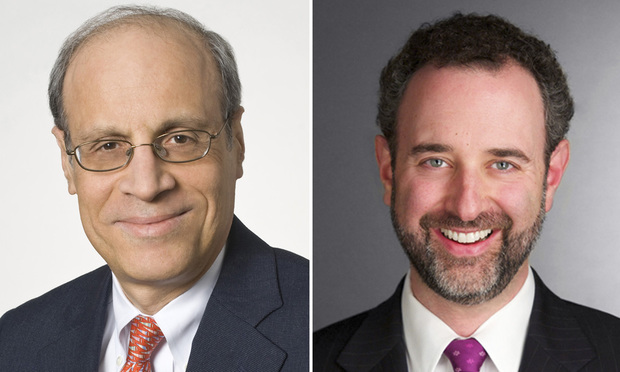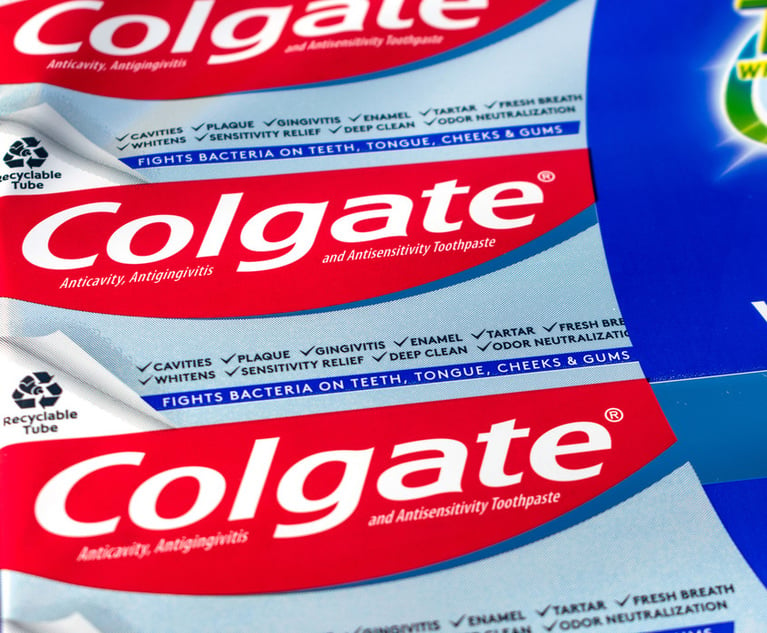How Courts in the Ninth Circuit Are Balancing Trademark Protection and Free Speech
A series of cases from courts within the Ninth Circuit have grappled with the issue of when a trademark owner's right to enforce its mark against misleading suggestions of origin “must give way to expressive speech protected by the First Amendment."
May 07, 2019 at 12:30 PM
8 minute read
The original version of this story was published on New York Law Journal
 Lewis R. Clayton and Eric Alan Stone
Lewis R. Clayton and Eric Alan Stone
Songs and paintings and all manner of expressive works often use other people's trademarks as part of their expression. Janis Joplin implored the Lord to provide her a Mercedes Benz. Courts have grappled with when a trademark owner's right to enforce its mark against misleading suggestions of origin “must give way to expressive speech protected by the First Amendment,” Caiz v. Roberts, No. CV 15-9044, 2019 WL 1755421 (C.D. Cal. April 17, 2019), as shown most recently in a series of cases from courts within the Ninth Circuit applying the two-prong test from Rogers v. Grimaldi, 875 F.2d 994 (2d Cir. 1989).
Trademark owners have generally fared poorly under the Rogers test; until recently the Ninth Circuit rejected trademark-infringement claims in all five such cases it had considered, finding that an artist's use of another's mark was protected by the First Amendment. See Gordon v. Drape Creative, 909 F.3d 257, 265 (9th Cir. 2018). That changed last year with Gordon, where the Ninth Circuit allowed a trademark-infringement claim against an expressive work to proceed. Gordon may suggest a softening of the road for infringement plaintiffs. Thus far, in the two post-Gordon cases in district courts in the Ninth Circuit, one has allowed the claims to proceed and the other granted summary judgment disposing of the claims. We report here on these cases.
The 'Rogers' Test
Rogers involved a trademark-infringement challenge by famed dancer Ginger Rogers against a fictional movie about two dancers, titled “Ginger and Fred,” the content of which “only obliquely relates to [Ginger] Rogers and [Fred] Astaire.” Rogers, 875 F.2d at 996. The Second Circuit held that a trademark-infringement claim could be brought against the title of an expressive work only if the party alleging infringement can show that: “[1] the title has no artistic relevance to the underlying work whatsoever, or, [2] if it has some artistic relevance … the title explicitly misleads as to the source or the content of the work.” Id. at 999.
Although the test was originally formulated to analyze allegedly misleading titles, the Ninth Circuit extended the Rogers test to “apply to the use of a trademark in the body of [a] work.” E.S.S. Entm't 2000 v. Rock Star Videos, 547 F.3d 1095, 1099 (9th Cir. 2008).
The Fifth, Sixth, and Eleventh Circuits have also adopted the Rogers test.
'Gordon v. Drape Creative'
Gordon created a popular YouTube video featuring a honey badger and variations of the phrases “Honey Badger Don't Care” (HBDC) and “Honey Badger Don't Give a S—” (HBDGS). The video became the subject of pop-culture references in television shows, magazines, and social media. Gordon trademarked HBDC for use with greeting cards and other classes of goods, eventually marketing honey-badger-themed goods, including greeting cards.
Defendants developed their own honey-badger-themed greeting cards, using the HBDC or HBDGS phrases with small variations. The district court granted summary judgment under Rogers, holding that Gordon's claims were barred by the First Amendment because (1) Gordon's mark was artistically relevant to defendants' greeting cards and (2) “Defendants do not explicitly misrepresent or in any manner affirmatively state or imply to the public that Plaintiff is associated with, sponsored, endorsed, or otherwise is the source of Defendants' greeting cards.” No. 2:15-cv-04905-JFW-PLA, D.I. 94 at 9 (C.D. Cal. Oct. 19, 2016).
As to Rogers's first prong, the Ninth Circuit held that “Gordon's mark is certainly relevant to defendants' greeting cards; the phrase is the punchline on which the cards' humor turns,” 909 F.3d at 269, explaining that “that the level of artistic relevance of the trademark … to the work merely must be above zero.” Id. Thus, Gordon had failed to raise a triable issue of fact with respect to the “artistic relevance” prong.
Under the second prong, the Ninth Circuit rejected the district court's “rigid requirement that, to be explicitly misleading, the defendant must make an 'affirmative statement of the plaintiff's sponsorship or endorsement.'” Id. Instead, the court examined “all of the relevant facts and circumstances” including “the degree to which the junior user uses the mark in the same way as the senior user.” Id. at 269-70. The court distinguished Gordon from its prior cases in which “the junior user has employed the mark in a different context—often in an entirely different market—than the senior user.” Id. at 270. According to the court, “the potential for explicitly misleading usage is especially strong when the senior user and the junior user both use the mark in similar artistic expressions” such that “there is at least a triable issue of fact as to whether defendants simply used” Gordon's mark “in the same way that Gordon was using it.” Id. at 271.
The court also examined “the extent to which the junior user has added his or her own expressive content to the work beyond the mark itself,” holding that “there is at least a triable issue of fact as to whether defendants simply used Gordon's mark with minimal artistic expression of their own.” Id.
Notably, as the court explained, “[a]lthough on every prior occasion in which we have applied the test, we have found that it barred an infringement claim as a matter of law” this “case … demonstrates Rogers's outer limits. Although defendants' greeting cards are expressive works to which Rogers applies, there remains a genuine issue of material fact as to Rogers's second prong—i.e., whether defendants' use of Gordon's mark in their greeting cards is explicitly misleading.” Id. at 261, 268. The court cautioned, however, that “Gordon's evidence is not bulletproof; for example, defendants' cards generally use a slight variation of the HBDGS phrase, and they list defendants' website on the back cover.” Id. at 271.
Upon remand the parties settled the case.
Post-'Gordon' Cases
Following Gordon, one district court in the Ninth Circuit has relied on Gordon to allow Lanham-Act claims to proceed, while the other granted summary judgment for the defendant.
Fierce v. Franklin Covey. Fierce, Inc. provides corporate training materials under the “Fierce” brand, including a book entitled “Fierce Leadership, a Bold Alternative to the Worst 'Best' Practices of Business Today.” Fierce alleged that Franklin Covey's “Fierce Loyalty: Cracking the Code to Customer Devotion” book infringed Fierce's trademarks. Fierce v. Franklin Covey, No. C18-1449-MJP, 2019 WL 1453573, at *1 (W.D. Wash. April 2, 2019).
Franklin Covey moved to dismiss, arguing that Fierce Loyalty is an expressive work and does not explicitly mislead customers. Applying the Rogers test and relying on Gordon, the district court found that Fierce “has alleged facts giving rise to a reasonable inference that the title is explicitly misleading.” Id. at *7. The court explained that “Franklin Covey used 'Fierce' in the same context and market in which it is used by Fierce Inc.” and that Franklin Covey followed the same naming convention as used by Fierce. Id. Thus, “consider[ing] 'all of the relevant facts and circumstances'” as Gordon instructs, the court denied the motion to dismiss because it was unable to “determine as a matter of law that Franklin Covey's use of 'Fierce' in Fierce Leadership was not 'an overt claim[] or explicit reference to'” Fierce, Inc. Id.
Caiz v. Roberts. Caiz, a hip-hop music artist, owns the trademark rights to the term “Mastermind” and has used the name in the music industry since 1999. Caiz alleged that Roberts, commonly known as “Rick Ross,” and other defendants infringed Caiz's trademark by releasing an album, creating a tour, and adopting a persona called “Mastermind.” Caiz, 2019 WL 1755421 at *1.
As to Rogers's first prong, the court held that “mastermind” was artistically relevant to the underlying work because “six of the nineteen songs on the album make direct use of 'mastermind,'” which “link[s] the title to its contents.” Id. at *5.
The court framed the issue under prong two as “whether Defendants' use of 'Mastermind' in their album and tour would confuse the public into thinking that Plaintiff is 'somehow affiliated with or sponsored by' Defendants.” Id. at *6.
Examining the case in view of Gordon's holding that “identical usage could reflect” an “explicitly misleading description,” the court distinguished this case from Gordon: “in contrast to the defendants in Gordon using the Honey Badger catchphrase as the 'centerpiece' of their greeting cards, Roberts is using 'Mastermind' as one album title out of six albums throughout his career.” Id. Additionally, according to the court, “even where the mark is used, it is through Roberts' own artistic expression,” and in “every instance where [the mark] was used [by Roberts] it was accompanied by a clear indication that it is associated with 'Rick Ross.'” Id.
Thus, the court granted defendants' motion for summary judgment, finding that Caiz “has not pointed to any evidence that creates a triable issue of material fact as to whether Defendants' album 'Mastermind' explicitly misleads as to the source of the work.” Id. at *7.
Lewis R. Clayton and Eric Alan Stone are litigation partners at Paul, Weiss, Rifkind, Wharton & Garrison. Michael F. Milea, an associate at the firm, assisted in the preparation of this column.
This content has been archived. It is available through our partners, LexisNexis® and Bloomberg Law.
To view this content, please continue to their sites.
Not a Lexis Subscriber?
Subscribe Now
Not a Bloomberg Law Subscriber?
Subscribe Now
NOT FOR REPRINT
© 2025 ALM Global, LLC, All Rights Reserved. Request academic re-use from www.copyright.com. All other uses, submit a request to [email protected]. For more information visit Asset & Logo Licensing.
You Might Like
View All



Colgate Faces Class Actions Over ‘Deceptive Marketing’ of Children’s Toothpaste
Trending Stories
- 1'No Retributive Actions,' Kash Patel Pledges if Confirmed to FBI
- 2Justice Department Sues to Block $14 Billion Juniper Buyout by Hewlett Packard Enterprise
- 3A Texas Lawyer Just Rose to the Trump Administration
- 4Hogan Lovells Hires White & Case Corporate and Finance Team in Italy
- 5New York District Attorneys Endorse Governor's Proposed Rollback of Discovery Reforms
Who Got The Work
J. Brugh Lower of Gibbons has entered an appearance for industrial equipment supplier Devco Corporation in a pending trademark infringement lawsuit. The suit, accusing the defendant of selling knock-off Graco products, was filed Dec. 18 in New Jersey District Court by Rivkin Radler on behalf of Graco Inc. and Graco Minnesota. The case, assigned to U.S. District Judge Zahid N. Quraishi, is 3:24-cv-11294, Graco Inc. et al v. Devco Corporation.
Who Got The Work
Rebecca Maller-Stein and Kent A. Yalowitz of Arnold & Porter Kaye Scholer have entered their appearances for Hanaco Venture Capital and its executives, Lior Prosor and David Frankel, in a pending securities lawsuit. The action, filed on Dec. 24 in New York Southern District Court by Zell, Aron & Co. on behalf of Goldeneye Advisors, accuses the defendants of negligently and fraudulently managing the plaintiff's $1 million investment. The case, assigned to U.S. District Judge Vernon S. Broderick, is 1:24-cv-09918, Goldeneye Advisors, LLC v. Hanaco Venture Capital, Ltd. et al.
Who Got The Work
Attorneys from A&O Shearman has stepped in as defense counsel for Toronto-Dominion Bank and other defendants in a pending securities class action. The suit, filed Dec. 11 in New York Southern District Court by Bleichmar Fonti & Auld, accuses the defendants of concealing the bank's 'pervasive' deficiencies in regards to its compliance with the Bank Secrecy Act and the quality of its anti-money laundering controls. The case, assigned to U.S. District Judge Arun Subramanian, is 1:24-cv-09445, Gonzalez v. The Toronto-Dominion Bank et al.
Who Got The Work
Crown Castle International, a Pennsylvania company providing shared communications infrastructure, has turned to Luke D. Wolf of Gordon Rees Scully Mansukhani to fend off a pending breach-of-contract lawsuit. The court action, filed Nov. 25 in Michigan Eastern District Court by Hooper Hathaway PC on behalf of The Town Residences LLC, accuses Crown Castle of failing to transfer approximately $30,000 in utility payments from T-Mobile in breach of a roof-top lease and assignment agreement. The case, assigned to U.S. District Judge Susan K. Declercq, is 2:24-cv-13131, The Town Residences LLC v. T-Mobile US, Inc. et al.
Who Got The Work
Wilfred P. Coronato and Daniel M. Schwartz of McCarter & English have stepped in as defense counsel to Electrolux Home Products Inc. in a pending product liability lawsuit. The court action, filed Nov. 26 in New York Eastern District Court by Poulos Lopiccolo PC and Nagel Rice LLP on behalf of David Stern, alleges that the defendant's refrigerators’ drawers and shelving repeatedly break and fall apart within months after purchase. The case, assigned to U.S. District Judge Joan M. Azrack, is 2:24-cv-08204, Stern v. Electrolux Home Products, Inc.
Featured Firms
Law Offices of Gary Martin Hays & Associates, P.C.
(470) 294-1674
Law Offices of Mark E. Salomone
(857) 444-6468
Smith & Hassler
(713) 739-1250






